Thomas A. Steitz
Biographical
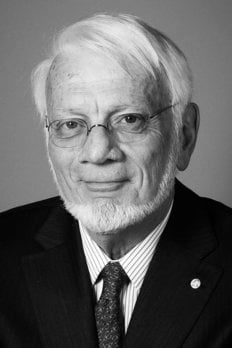
I was born in Milwaukee, Wisconsin in 1940, and my family lived in an apartment above a paint store in the downtown area until 1949. Although my father had obtained a law degree from Marquette University in Milwaukee, he became the administrator in charge of personnel at the Milwaukee County Hospital. My mother grew up on a farm in Waukesha county outside of Milwaukee and graduated from Carol College, a small college in Waukesha. My mother devoted her time to all of the domestic chores required for raising a family which eventually grew to five children – two younger brothers and two younger sisters. My father’s parents lived about 20 blocks away and my mother’s parents and her brother’s family lived on the family farm in Waukesha county.
I attended elementary school at the Elm Street School, an old brick building with an asphalt playground located a few blocks from our apartment. I did not like the school much and often got beaten up by a bunch of slightly older guys on my way home from school. My report card, which I brought home for my parents’ signatures at the end of second grade, showed grades that were just above failure. My parents were upset and asked what I was going to do to change, and I said that I did not really care about the grades. My mother (I think) then applied the “board of education” to the “seat of knowledge” – my first and last spanking. This was definitely the low point of my academic career.
In the middle of my third grade school year we moved from 27th Street to a new house on 75th Street in the Milwaukee suburb of Wauwatosa and my life was transformed, academically and in all other ways. My teachers, schools and classmates were all marvelous in grade school, junior high and high school. The Roosevelt grade school playground had tennis courts and a grass playing field, on which a large skating rink was made every winter with a warming hut and outside lights added. Almost every evening in the winter I would go skating for hours with friends playing team skating games.
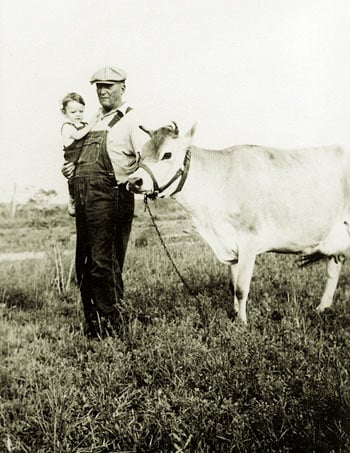
Visits to my grandfather’s farm during the 1940s and 50s played an important role in my life in that period. His farm was what is referred to as a “truck farm” where he grew vegetables, mostly radishes, carrots and onions. In the WWII years, however, he had a cow for milk, cream and cheese and a picture from about 1941 shows me with my grandfather and his cow (Fig. 1). My family made frequent visits to the farm, which was only about a 30 minutes drive from Wauwatosa. A picture of my parents and their five children standing in front of my grandfather’s green Hudson car, taken in about 1952, shows a harvested wheat field and one of my grandmother’s gardens (Fig. 2).
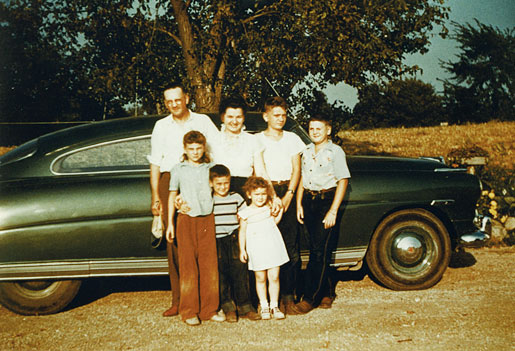
During my early teenage years I spent most of my summer school vacation working in the fields on my grandfather’s and uncle’s farm. I worked with many other kids, bunching radishes and weeding 20 acres of onions. Work would start just after sunrise at about 5:00 a.m. and continue to late afternoon every day, except Saturday. (The market was closed on Sunday.) I received 5 cents per dozen bunches of radishes and often tied as many as 100 dozen. I used the money to buy myself a new saxophone, a bicycle and a tennis racquet and save money for college.
The junior and senior high schools were about a 20 minute walk away and introduced me to an additional set of classmates and importantly to music, art and shop besides the academic courses. The shop courses in junior high included electricity and magnetism, where I made an electric motor from scratch, winding the wire coils and making all of the connections. In the woodworking shop I made a coffee table for the family. In the plastics shop I made letter openers and light stands. I do not remember what I did in metal working. I have found that the basic skills in working with tools and materials that I learned in the shop courses have proven invaluable for me in subsequent years, at home and in the laboratory, including constructing models of proteins. I think it is unfortunate that such courses have been eliminated in many schools today as being unnecessary or too expensive.
I developed a serious interest in music in junior high school, where I joined the band and the choir. On the first day of band practice I brought my father’s C melody saxophone to the band leader, who told me it would not work in the band but lent me the school’s E flat alto-saxophone. I became a very serious saxophone player and in high school played solos, duets, quartets as well as organizing a big band style dance band in addition to playing in the school band. I practiced one to two hours a day at home and won a number of “gold” medals at state contests when I was in high school. I seriously considered becoming a musician, but then concluded I could do music as a hobby if I went into science, but could not do science as a hobby if I went into music.
My grades in Longfellow Junior High School were mostly B’s during my first two years – good but not great. Then, my younger brother Dick entered junior high during the middle of my second year, and he got straight A’s. This was a wake up call for me and the competition was on. I believe I got mostly A’s the next year. I did much better in high school, graduating 8th in a class of over 300. Competition can be motivating in the classroom as well as on the tennis court.
Fortunately, the students in all of my courses in high school were separated according to their academic ability in a particular field. Thus, the very best 25–30 students of the 300 total were in my math, science and English classes. This, of course, meant that the teacher could instruct us at a much higher level than if the students in the classroom were a random selection from the whole class, and we learned from and were challenged by our fellow students. I particularly remember how extraordinarily good the girls were in my math classes – only two or three of the top ten were boys. I have never had any doubt that women are as good at or better than men in math, contrary to the impressions of a former president of Harvard. I think it is very unfortunate that many, if not most, high schools (like the one in my home town of Branford, CT) no longer separate students by ability; this does not motivate or properly educate the very best students.
Lawrence College
My choice of what college to attend was heavily influenced by my best high school friend, Alex Wilde, and most importantly, by his mother. My father wanted me to attend Marquette University or the University of Wisconsin, Milwaukee, neither of which appealed to me. I had gotten to know the Wilde family very well, particularly Alex’s mother whose father was the then Senator Wiley from Wisconsin. She suggested that I apply to Lawrence College where Alex was intending to go, and since I could not afford the tuition, that I should apply for a scholarship, which I did. I received a full tuition scholarship for four years and upon visiting Lawrence College I knew where I wanted to go to college – an important choice.
My four years at Lawrence College changed my life, my view of the world and my professional direction. Since Lawrence is a liberal arts school, I was required to take many humanities courses to supplement what turned out to be my major in chemistry. These courses began with what was called a Freshman Studies course which was a broad based reading, discussion and writing course on many classical books. We learned to ask as well as answer questions. Importantly, we were also required to take a philosophy course, a scholarly based (e.g., Niebuhr, etc.) religion course, and an anthropology course, as well as English, History and language courses. I entered Lawrence with a heavy religious background and left it with an entirely different understanding of the origins of religious beliefs, their veracity and their roles in cultures. Lawrence also has a music school so that I was able to continue my love of music by participating in the band, orchestra and choir.
While I had many wonderful, inspiring teachers at Lawrence, the person who had by far the greatest influence in inspiring me to pursue a career in science, and in particular chemistry, was Professor Robert Rosenberg, or Bob as I can now call him (Fig. 3a). I still recall the early lectures in his introductory chemistry course where he introduced to us the concepts of atomic orbitals and bonding and how studying chemistry at the physical chemical atomic level allowed us to understand the properties of chemicals, such as their color. It was a wonderful revelation to me about how the world around me could be understood.
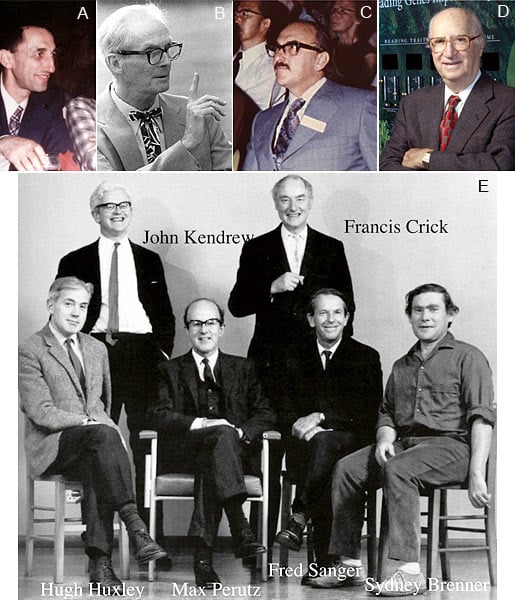
I had several opportunities to work on research projects in laboratories outside Lawrence. The first opportunity, which was arranged by Bob Rosenberg, was to spend the summer between my junior and senior years doing research in the biochemistry laboratory of Lorazo Lorand at Northwestern University. My project was a kinetic study (determine kcat and Km) of the hydrolysis of a variety of para-nitrophenyl ester substrate analogues by chymotrypsin, trypsin and thrombin. After making the measurements, I started the calculations, which seemed tedious. I then decided to write a computer program (my first) to process the data on the university IBM 650. The process went so quickly that I finished my summer project two weeks early and asked what I should do next. I was told to do some organic synthesis of a new substrate compound, which I began. While working in the hood with some organic solvents, in the presence of a lit Bunsen burner, the solvents, not surprisingly in retrospect, exploded (fortunately without any injury), and that ended the organic chemistry phase of my research career.
The end of summer before my senior year in 1961, I was invited to participate in a two week conference at MIT for selected science students from small colleges. This unique meeting was organized and paid for by the American Biophysical Society in order to encourage students to consider the field of biophysics (of which I had never heard). Four students each from about two dozen top small colleges were invited to participate, all expenses paid. It was my first trip on an airplane and my first trip outside of Wisconsin, except for Chicago. The venue consisted of lectures on a broad range of biophysical topics by faculty, mostly, but not exclusively, from Harvard and MIT. I remember one of the organizers, J. Oncley, sitting in the audience with the most wrinkled plaid sport coat I had ever seen. Most memorable, not only for its exciting content, was a lecture by Alex Rich. His lecture was truly inspiring and in an area of research I pursued years later. He was dressed in a fine dark suit (not today’s lecture garb) with a white shirt and tie. Another important lecture for me was given by Paul Doty from Harvard on biophysical studies of nucleic acids, which was one of the reasons for my later wanting to attend Harvard. Students at the conference also had a great opportunity to interact with each other and go out to dinner together in various parts of Boston and Cambridge. I particularly remember dining with three Reed College students, who included Don Engelman and Mark Ptashne, as well as a few others who subsequently became fellow graduate students at Harvard. This two-week meeting was possibly inspired in part by the Kennedy call to respond to Sputnik. It was a truly important event for influencing the career choices of many of us, but unfortunately was not repeated.
In the fall of my senior year I participated in a research program for selected students sponsored by the Midwestern small colleges at Argonne National Laboratory. I lived on the lab grounds and worked on a chemistry project that I neither liked nor remember. All I remember of the dull semester was my first opportunity to see the Moscow Bolshoi Ballet and marvel at the ability of the male dancers to leap across the stage. During the summer between Lawrence and starting studies at Harvard I worked for Dupont on another forgettable project, measuring the dynamic stretching modulus of various synthetic cloth materials being considered for use in making bras. Unfortunately, I was not invited to join the group that evaluated the final product being modeled.
Harvard University
I went to Harvard as a graduate student to work on biophysical studies of nucleic acids, but fortunately, chose a different pathway. In the spring of my first year in 1963, I attended three Dunham lectures given by Max Perutz (Fig. 3E) in which he presented the first atomic resolution protein crystal structure, that of myoglobin. He showed stereo slides, and I was stunned to see the atomic structure of myoglobin pop out in three dimensions over Max’s head; this was clearly the way to understand how macromolecules carry out their biological functions. Shortly thereafter, while playing tennis with a Lipscomb graduate student (Peter Boer), I mentioned how unfortunate it was that no one was doing protein crystallography at Harvard. He said on the contrary, the “Colonel”, as Bill Lipscomb (Fig. 3B) was referred to by his students and postdocs since he was from Kentucky, had a group who were working on the crystal structure of bovine carboxypeptidase A (CPA). Shortly thereafter I made my way to the Colonel’s office, a little nervous because I had already been turned down (fortunately) by another faculty member, in order to make an appointment to see him. He was standing in the office of his secretary, who was not there, and when I asked if I could make an appointment to see him, he invited me right in. After he described the CPA project, I excitedly asked if I could join the project, and he said yes. So, I had just received the wonderful opportunity to join the Colonel’s army, and the rest is history.
The CPA team consisted of five postdocs at that time, of whom Martha Ludwig was the most important for my training. I worked with her on structural studies of substrate and inhibitor complexes of CPA as well as with the whole group on the determination of the crystal structure of the apo protein. I remember being excited at one time when we succeeded in collecting 5,000 reflections in one week using the Hilger-Watts linear diffractometer. Now, of course, we can collect 5,000,000 reflections from ribosome crystals of the ribosome in an hour (about a factor of 105 faster for an assembly that is about 80 times larger). All computer programs were written in Fortran for an IBM 7094 computer that had 32 K of memory, had no discs and used computer cards. The advantage of the latter was that we could save the used cards and sell them as used paper in order to support lab parties every few months. (I always thought we should have written a program called GENCARD to increase the party frequency.)
Because of the superb team that the Colonel assembled and his encouraging management style, the project moved on well. In 1966 we published a 6 Å resolution map, including a model of the polypeptide backbone that I had over-optimistically built, but showing many of its structural features. Martha and I, with postdoc Flo Quiocho, published a low resolution map of an inhibitor complex that showed the first example of a substrate induced conformational change. In 1967 we obtained what I realize in retrospect was a superb 2.0 Å resolution electron density map of the apo-CPA that allowed us to correctly position every residue of the polypeptide backbone, even in the absence of an amino acid sequence. CPA tied in 1967 with three other proteins, RNase A, RNase S and chymotrypsin, for being the third highresolution protein structure determined after myoglobin and lysozyme.
Unlike PIs today, the Colonel was almost never absent from the lab to attend meetings and present seminars. He did, however, take a sabbatical in England, and while he was gone, I came up with the idea of using direct methods to phase the Fderivative-Fnative difference coefficients in order to calculate a projection difference Fourier map, which clearly showed the heavy atom positions. When I showed him the paper I had written on the work upon his return, he allowed me to publish the paper in Acta Cryst. without his being a co-author, also not a common practice among PIs today.
The Colonel provided me with what turned out to be a great opportunity that had an important impact on my future faculty job opportunities when he arranged for me to give a talk at the Protein Gordon Conference, which was chaired by Fred Richards in the summer of 1966. I talked about the CPA structure and the conformational change produced by substrate or inhibitor binding, the concept of induced fit. Dan Koshland was a participant and greatly appreciated this new experimental evidence for his hypothesis of substrate-induced conformational changes. I assume that my talk and opportunity to meet him partly motivated his advocating that the Berkeley Biochemistry Department interview me and offer me a faculty position, which they did, and I accepted in the late spring of 1967. Due to the reluctance of the Department to consider hiring a woman for a faculty position (Joan) in 1970, I resigned my Berkeley position after two months on the faculty and accepted a position at Yale offered by Fred Richards.
The Laboratory of Molecular Biology, Cambridge
After Harvard and before going to Berkeley I spent 3 years at the MRC laboratory of Molecular Biology in Cambridge from 1967 to 1970 in the group of David Blow. He was recommended to me by Hilary Muirhead, who was a postdoc with the Colonel and a former student with Max Perutz. In David’s lab I worked with Richard Henderson on determining the structure of chymotrypsin complexes with substrates.
The Cambridge Laboratory of Molecular Biology was a completely unique and outstanding laboratory. It inspired and trained a very large group of postdocs from the U.S. in molecular and structural biology who then returned and transformed these fields in the U.S. Perhaps the most remarkable and unique feature of the laboratory was the canteen located on the top floor which provided coffee in the morning, lunch after mid-day and tea in the afternoon. The attraction was definitely not the “bangers” or, the “toad in the hole” or other culinary opportunities, but sitting down with a random collection of lab directors, postdocs and graduate students and talking about science. The canteen was set up by Max and run by his wife, Gisela. When I first arrived, it was so small that whenever I got through the food line, there were only a few empty seats. Consequently, I would have to sit at a table that might include Max, Francis Crick and Sydney Brenner (Fig. 3E) at it as well as postdocs and students. Within about two months I had met nearly everyone in the whole laboratory. The conversations were always about science and about experiments, never about the movie someone saw the previous night. Everyone contributed suggestions and/or criticisms. Initially I wondered how anyone got any experiments done since they were spending so much time in the canteen, and then I realized that the many discussions reduced the number of unwise or unnecessary experiments that were done and enhanced the good ones.
There were no weekly group meetings, but there was an annual one-week meeting for essentially everyone in the LMB which was generally known as “Crick week”. Francis would sit in the front row and frequently ask many questions. On one occasion I remember Fred Sanger presenting a talk on his recent research and in the middle Francis jumped up and said “Fred, if you did (this) and (this) and (this), then you would be able to find out (that) and (that)”. Fred, without taking his hand off the chalkboard turned toward Francis and said, “That’s it, Francis, that’s it; you’ve got it”, and then carried on. Since Crick week included a broad range of molecular and structural biology topics, it was very useful that directors in the front row would ask questions that many of us were reluctant to ask. During one lecture that involved a comparison of a process that occurs both in eucaryotes and procaryotes, Max asked, “What is a eucaryote and what is a procaryote?”, terms that were just beginning to be used. I was glad that Max asked the questions, since I had no idea what the terms meant. Sydney Brenner would have coffee available in his lab dishwashing kitchen on Saturday morning about 10:30 or so and would always be there with the postdocs and students from the molecular biology floor directed by himself and Francis, plus others of us who wanted to drop by. Sydney would invariably hold forth on some interesting topic with lots of funny stories and “one-liners”.
I learned about all of the major research problems being pursued at the LMB from Crick week, the canteen, Saturday coffee and the random conversations in the hall, as well as the quick evening trip to the pub for “last call”, which the American postdocs did. (The Brits were mostly not there at night.) It was at this time that I developed my interests in trying to understand the structural bases of the mechanisms by which the many proteins and nucleic acids that are involved in “Crick’s Central Dogma” carry out their functions: how DNA is copied into DNA, DNA transcribed into RNA and finally the RNA translated to protein.
Access to computing facilities was extremely limited at Cambridge. The LMB used the computer owned by the Cambridge University astronomy department, and we were allowed to make only two submissions a day for the five working days, and the morning run could not take more than two minutes. I would check and recheck the computer cards I was submitting to eliminate as many mistakes as possible, because otherwise one of 10 opportunities would be lost to me for the week. In retrospect, it is amazing that we were able to accomplish anything. Certainly, the timescale was longer.
At some point in my second year Brian Hartley (Fig. 3C), who was collaborating with David Blow on chymotrypsin studies, came up to me and asked what research project I planned to pursue when I left the LMB and went to Berkeley. I said I wanted to solve the structure of an aminoacyl-tRNA synthetase, ultimately complexed with substrates including tRNA. This is the step where a specific amino acid is attached to the tRNA containing the correct anticodon. Brian patted me on the back and said “There, there, my boy. That is an interesting problem, but you must work on something you can actually do successfully. I suggest that you study the structure of hexokinase”. I thanked him for the advice and ran down to the library to find out what hexokinase was. I subsequently learned by reading papers from Dan Koshland (Fig. 3D) that the hexokinase reaction was his primary example of why some enzymes must undergo a substrate-induced fit conformational change. He reasoned that if the enzyme was rigid with all of its catalytic groups properly oriented to catalyze the nucleophilic attack of the six-hydroxyl group of glucose on the alpha phosphate of ATP, then why would water not hydrolyze ATP in the absence of glucose? The six-hydroxyl group is after all a water molecule with some carbons attached. He hypothesized that the binding of glucose must cause a conformational change in the enzyme that is necessary for catalysis. I consequently started growing crystals of hexokinase at Cambridge and spent the next 10 years studying this enzyme. Mentorship is always essential, and not only from your direct supervisor.
I submitted my first grant application to the NIH in 1969, I believe, in which I proposed to determine the structures of yeast hexokinase, of which I had managed to produce crystallographically suitable crystals. I had to go to Berkeley for a site visit by an NIH panel and was asked by a panel member how I was going to collect the x-ray data. I said by using a diffractometer, whereupon I was told that data collection with a diffractometer would not work because the unit cell dimensions of my hexokinase crystals were too big (one dimension was 200 Å). This, of course, was a ridiculous comment, since one just moves the detector further away from the crystal, but the reviewer was firm and ultimately my first application was turned down. (A few decades later this reviewer asked me in an elevator while being escorted to my next faculty visit how we had solved the structure of hexokinase, and I said “by using a diffractometer to collect data”.)
Sometime at the end of 1969 or early 1970, Fred Richards (Fig. 4D) was visiting the LMB, and I had an opportunity to talk to him. Since I had become worried about my funding at Berkeley, I asked him whether a faculty position for me was possible at Yale, and he said he would look into it and get back to me. Years later I learned from Sydney Brenner, while dining with him at King’s College, that Fred had run up to his office after talking to me and asked him if he could encourage another American postdoc in Sydney’s lab to either accept or reject the offer that he had received from Yale. Sydney immediately called the postdoc into his office, closed the door, put a piece of paper on the table and told the postdoc that he would not be allowed to leave the room until he had written and signed a letter to Fred either accepting or rejecting Yale’s offer. Sydney then took the letter rejecting Yale’s offer to Fred, who left Cambridge with two faculty slots in his pocket. Fred had wanted to have two positions available, since there were faculty in the department who wanted to hire Joan, and perhaps Fred thought Yale might have an advantage over Berkeley if they offered both of us jobs. Indeed, that turned out to be true.
Yale
I arrived at Yale in the late fall of 1970 and began our structural studies of yeast hexokinase captured with and without the substrate glucose bound, a project that occupied the efforts of most of my lab during the 1970s. I was extremely fortunate to have Robert Fletterick join my lab to work on hexokinase as my first postdoc during my first year at Yale. Bob had come to Yale to do a postdoc with Hal Wyckoff and had a fellowship. He decided he wanted to switch labs, and Hal was very accommodating. Our structures of hexokinase with and without glucose bound showed the largest conformational change in a single subunit that had been observed at that time and clearly established that Koshland’s induced fit hypothesis was correct for explaining the specificity of hexokinase. The pictures of our hexokinase structures with and without glucose bound have been published in far more textbooks than any other work from my lab. Brian Hartley had certainly made a good suggestion for what research direction I should pursue, and I can only wonder what I would have accomplished in the 1970s had I not had the hallway hexokinase discussion with Hartley.
A very important factor in making the quality of structural biology so excellent at Yale beginning in the 1970s was the shared computation and x-ray facility, the “core” laboratory, and the many interactions it facilitated. When I arrived in 1970, Fred Richards and Hal Wyckoff, who solved the structure of RNase S in 1967, had a shared x-ray and computation lab that I joined and added some equipment. In 1975 I suggested to Fred that we should consider applying for an NIH program project grant, which I had just learned about, to support our structural biology efforts, and Fred took the lead in organizing five of us, the WERMS group (Wyckoff, Engelman, Richards, Moore and Steitz), to apply which we did successfully in 1976. The “WERMS” grant, as we referred to it, is now in year 34, but I am the only WERM left on it. In the late 1980s, funding from HHMI provided additional support for the core x-ray and computational lab, including two technical staff positions and additional equipment. They also provided an investigator position for me as well as additional faculty/investigator positions for the MB&B department, and in the mid-1990s the WERMS group also included Paul Sigler, Axel Brünger and Jennifer Doudna (Fig. 4).
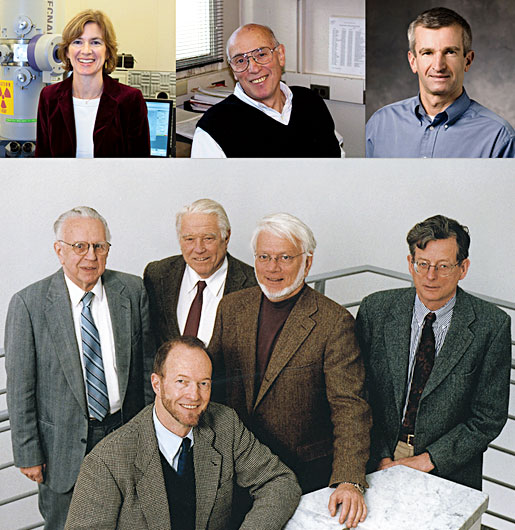
This group of seven laboratories constituted the Yale Center for Structural Biology (CSB) and Fred Richards was appointed by the Yale president to be the first director of the CSB. The shared core computation and diffraction laboratory was always abuzz with the activity of students, postdocs and technical staff who interacted and helped each other solve problems. In the mid-1990s there were six technical staff in the core lab to help users with problems they encountered, and about 100 postdocs, students and technical staff in the CSB laboratories. All of the seven faculty members of the CSB in 1995 (when our work on the ribosome began) are or were in the U.S. National Academy of Sciences. In the mid-90s, these seven labs and their extensive and collegial interactions provided perhaps the best environment in the world for doing structural biology in general and determining the structure of the ribosome in particular.
Son Jon
Our son Jon was born in 1980 and met his first Nobel Prize winner, Fred Sanger, at the age of 4 weeks during an MRC LMB celebration on the day of Fred’s being awarded his second Nobel Prize in chemistry. We happened to be in Cambridge on that day, after attending meetings in Switzerland, Germany and London. Jon got to go to many meetings around the world for the next fifteen years until baseball took over his world.
I started playing tennis and baseball with Jon when he was in grade school and installed a basketball hoop on the garage for him. Every weekend in the summer we would go to a baseball field in our home village of Stony Creek to practice his throwing, catching and batting skills. That lasted until he started hitting the ball out of the park into the salt marsh grass. In high school he was quarterback on the football team, guard on the basketball team and pitcher on the baseball team for four years. At the end of his senior year he was drafted in the 44th round of the baseball draft, but wisely chose to go to Yale. At Yale he majored in molecular biophysics and biochemistry, and baseball, as did two of his classmates and teammates, Craig Breslow and Matt McCarthy. At the end of his junior year, Jon was drafted by the Milwaukee Brewers (ironically) in the third round and received a signing bonus that was slightly larger than my share of the 2009 Nobel Prize. After a shoulder injury caused him to leave baseball, he went to Yale Law School and is now working in consulting with McKinsey Corporation. Breslow, who worked in Joan’s lab as an undergraduate and intended to go to medical school, had also been drafted by the Brewers and is now pitching for the Oakland Athletics team.
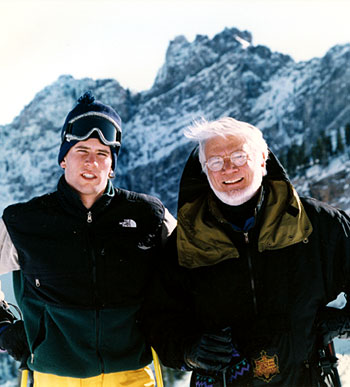
Jon learned to ski by coming on what we now refer to as “Riboski” trips. Starting in the late 80s, a group of RNA-centric friends and their kids started going on annual ski trips together: Tom and Carol Cech (+2); Jim and Elsbet Dahlberg (+2); John Abelson (+1) and Olke and Lori Uhlenbeck. Since we sent the kids to take ski lessons while the adults skied together, Jon quickly improved, and by the age of 12 he could ski circles around me. Perhaps my most memorable ski trips were my two 4-day trips with Jon to Snowbird in Utah over Thanksgiving break during his junior and senior years in high school (Fig. 5). He would ski the double black diamond runs while I would ski the double blue or black diamond trails and we would meet at the bottom of the ski lift.
The Structural Basis of Crick’s Central Dogma of Molecular Biology
Our decades’ long quest to obtain a structural understanding of the mechanisms by which the macromolecules that carry out the process of DNA makes DNA makes RNA makes protein – Crick’s central dogma – began with our establishing the structure of the catabolite gene activator protein (CAP) with only cAMP bound in 1981. This was the first structure of a DNA binding protein, a transcription activator. Our subsequent structure of CAP bound to DNA in 1991 showed a remarkable bending of the DNA backbone, and our recent structure of the unliganded CAP exhibited a very large conformational rearrangement of the DNA binding domains which explains how the binding of cAMP activates the ability of CAP to bind to DNA.
In the 1980s we also determined the first structure of a DNA polymerase, the Klenow fragment of DNA polymerase I (whose discovery by Arthur Kornberg led to his receiving the Nobel Prize) and its complex with a DNA substrate in the 3′-5′ exonuclease active site. The structure of the substrate complex led to our discovery of the two-metal-ion mechanism of a phosphoryl transfer reaction and our later proposal that this mechanism is employed by many ribozymes, which has recently shown to be the case for several of them. We also published our first structure of a fragment of the site specific recombination enzyme, gamma delta resolvase, that lacked its sequence specific DNA binding domain. Perhaps the most exciting (to me) leap forward in the late 80s was our obtaining the structure of glutaminyl-tRNA synthetase complexed with tRNAGln and ATP. This was the problem I had wanted to work on 20 years earlier when Brian Hartley wisely advised me that it was too early. Obviously, he was correct. This first structure of a synthetasetRNA complex showed how the synthetase recognizes the correct tRNA containing the glutamine anticodon and discriminates against all of the other tRNAs. This is the first critical step in the translation of the genetic code into proteins.
We had many exciting advances in our central dogma quest in the first half of the 1990s. We obtained the first structure of HIV reverse transcriptase complexed with a non-nucleotide inhibitor, which was then one of the few drugs used to treat patients with AIDS. We also determined the first of the many structures of T7 RNA polymerase that we have obtained over the last 15 years captured in many of its functional states. This was the beginning of our exploring how DNA is transcribed into RNA starting with an initiation state with T7 RNA polymerase bound to its promoter and going on to the elongation and termination states. Significant progress was also made in our studies of DNA recombination. We obtained the first structure of an enzyme involved in homologous recombination, recA, and the structure of the site specific recombinase, gamma delta resolvase, bound to its specific DNA target. While this latter structure illuminated how resolvase recognizes its DNA target, it did not reveal how the protein brings the two DNA duplexes together to form a synaptic complex or how strand exchange is accomplished; that would take us another 10 years. We also obtained the structure of the first binary complex of a DNA polymerase (Klenow fragment) with its duplex DNA substrate bound to the polymerase active site, but without the incoming dNTP.
By 1995, then, we had made significant progress on obtaining structural insights into the mechanisms of all of the steps of the central dogma except the last one – protein synthesis by the ribosome. It was at this time in the fall of 1995 that Nenad Ban joined by lab and said he wanted to work on the structure of the ribosome – the right person at the right time. As discussed in more detail in the Nobel lecture, we collaborated with Peter Moore and Ban was joined later by Poul Nissen and Jeff Hansen. Between 1995 and 2000 our goal of obtaining the structure of the 50S ribosomal subunit and a complex with a transition state intermediate was attacked successfully by the swat team of these three postdocs (Fig. 6). Jeff Hansen also determined the structures of many complexes between the Haloarcula marismortui 50S subunit and antibiotics bound to the peptidyl transferase center, which formed the basis for our founding of Rib-X Pharmaceuticals, Inc. Subsequently, substrate complex structures were pursued by a graduate student, Martin Schmeing, in the early 2000s (Fig. 6). During the 1990s our small ribosome group had daily conversations and regular meetings around a lunch table to discuss progress and ideas for moving forward. The calculation of the 2.4 Å resolution electron density map in early 2000 and our months of building a model of the ribosome were the most exciting research times I had ever experienced. We had no idea what the ribosome structure, particularly the RNA, would look like and peering into its emerging interior was simply amazing
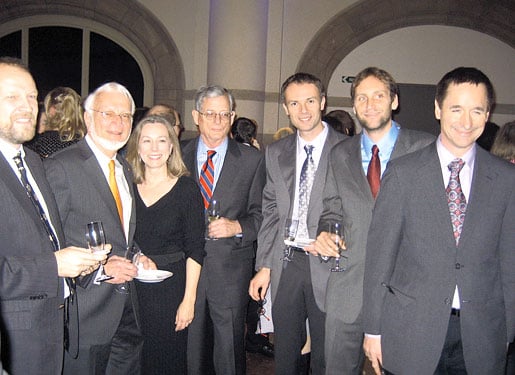
Looking back over the development and progress of my career in science, I am reminded how vitally important good mentorship is in the early stages of one’s career development and constant face-to-face conversations, debate and discussions with colleagues at all stages of research. Outstanding discoveries, insights and developments do not happen in a vacuum. Our research accomplishments on the structures of the large ribosomal subunit and its many complexes were greatly enhanced and accelerated by the structural biology environment at Yale in the 1990s as well as the long term support of risky projects by the Howard Hughes Medical Research Institute. As I watch increasing numbers of my faculty colleagues, students and postdocs communicate with each other almost exclusively by email rather than discussing ideas over the lunch table (as I experienced in Cambridge and the first decades at Yale), I wonder whether they will be as creative and have as much fun doing science as they could with more face-to-face contact.
This autobiography/biography was written at the time of the award and later published in the book series Les Prix Nobel/ Nobel Lectures/The Nobel Prizes. The information is sometimes updated with an addendum submitted by the Laureate.
Thomas A. Steitz died on 9 October 2018.
Nobel Prizes and laureates
Six prizes were awarded for achievements that have conferred the greatest benefit to humankind. The 12 laureates' work and discoveries range from proteins' structures and machine learning to fighting for a world free of nuclear weapons.
See them all presented here.
